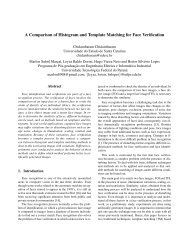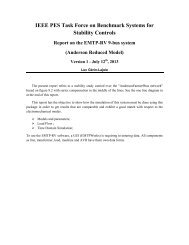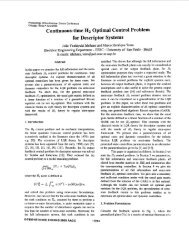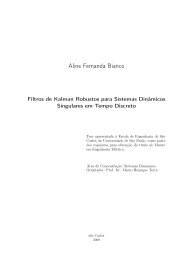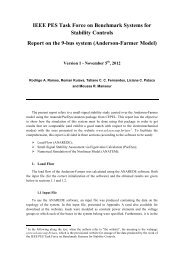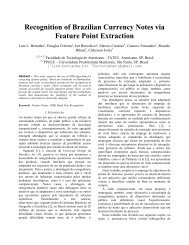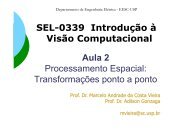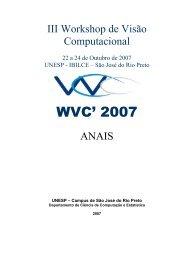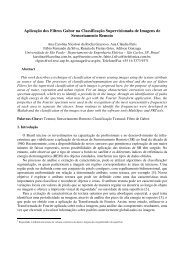Análise de Observabilidade e Processamento de Erros Grosseiros ...
Análise de Observabilidade e Processamento de Erros Grosseiros ...
Análise de Observabilidade e Processamento de Erros Grosseiros ...
Create successful ePaper yourself
Turn your PDF publications into a flip-book with our unique Google optimized e-Paper software.
RESUMO<br />
Este trabalho apresenta estudos sobre a mo<strong>de</strong>lagem em tempo-real <strong>de</strong> sistemas <strong>de</strong> potência<br />
através da estimação <strong>de</strong> estado generalizada. As principais funções da estimação analisadas<br />
foram: processador topológico, observador, estimador <strong>de</strong> estado e análise <strong>de</strong> erros grosseiros. Os<br />
dispositivos <strong>de</strong> chaveamento (chaves e disjuntores) são representados através <strong>de</strong> mo<strong>de</strong>los <strong>de</strong> impedância<br />
nula. A mo<strong>de</strong>lagem do sistema na sua forma mais <strong>de</strong>talhada, através da representação<br />
<strong>de</strong> subestações com todas chaves e disjuntores, permite a verificação <strong>de</strong> erros <strong>de</strong> status <strong>de</strong>sses<br />
componentes. Portanto, a análise da topologia po<strong>de</strong> ser realizada simultaneamente à estimação<br />
<strong>de</strong> variáveis <strong>de</strong> estado convencionais. Chaves e disjuntores, que são elementos <strong>de</strong> impedância<br />
nula, são consi<strong>de</strong>rados no mo<strong>de</strong>lo generalizado através da adição <strong>de</strong> variáveis <strong>de</strong> estado do tipo<br />
fluxo e <strong>de</strong> pseudomedidas a<strong>de</strong>quadas. A interação entre dispositivos <strong>de</strong> característica discreta e<br />
medidas analógicas e a diferença entre os mo<strong>de</strong>los convencional e generalizado são enfatizados<br />
em cada função. Dois mo<strong>de</strong>los <strong>de</strong> estimador são consi<strong>de</strong>rados: um baseado no método <strong>de</strong>sacoplado<br />
a partir da formação da matriz ganho e o segundo baseado no método Tableau esparso<br />
<strong>de</strong> Hachtel, on<strong>de</strong> pseudomedidas <strong>de</strong> injeção nula são consi<strong>de</strong>radas como restrições <strong>de</strong> igualda<strong>de</strong>.<br />
A análise <strong>de</strong> erros grosseiros proposta busca tratar um erro reconhecido pela dificulda<strong>de</strong> na sua<br />
<strong>de</strong>tecção: o erro conformativo. As medidas afetadas por esse tipo <strong>de</strong> erro agem como fossem medidas<br />
regulares e seus efeitos atingem medidas sem erro grosseiro. Nesse caso, as metodologias<br />
tradicionais quando aplicadas, po<strong>de</strong>m i<strong>de</strong>ntificar incorretamente as medidas. A i<strong>de</strong>ntificação<br />
<strong>de</strong> erros conformativos foi formulada através da teoria da <strong>de</strong>cisão e a partir da consi<strong>de</strong>ração<br />
da confiabilida<strong>de</strong> das medidas formula-se como um problema combinatório. É sabido que Metaheurísticas<br />
são eficientes no tratamento <strong>de</strong> tais problemas e a Busca Tabu é proposta para<br />
i<strong>de</strong>ntificação e elaboração <strong>de</strong> hipóteses que melhor expliquem as incoerências encontradas.<br />
ABSTRACT<br />
This work presents studies about power system real-time mo<strong>de</strong>ling by using generalized state<br />
estimation. The analyzed state estimation functions are: topological processing, observability<br />
analysis, state estimator and gross error analysis. All these functions are consi<strong>de</strong>red by a generalized<br />
approach, where switching components (switches and circuit breakers) are represented<br />
by zero impedance mo<strong>de</strong>ls. Consi<strong>de</strong>ration of <strong>de</strong>tailed mo<strong>de</strong>l through explicit representation of<br />
substations with all switches and circuit breakers allows topology analysis with estimation of conventional<br />
state variables simultaneously. Switches, circuit breakers (zero impedance branches),<br />
are represented by the insertion of new flow state variables followed by a<strong>de</strong>quate pseudomeasurements.<br />
The interaction among components and measurements of different natures and differences<br />
between conventional and generalized mo<strong>de</strong>ls were emphasized for each function. Two<br />
state estimator mo<strong>de</strong>ls are consi<strong>de</strong>red: the first one is based on <strong>de</strong>coupled state estimation by<br />
using the gain matrix, the second one is based on Hachtel’s sparse tableau approach. The proposed<br />
gross error analysis aims to treating an error that is known by its <strong>de</strong>tection difficulty:<br />
the conforming error. Measurements affected by this error act as regular measurements and the<br />
negative effects act over good measurements. In this case, conventional i<strong>de</strong>ntification methods<br />
may fail and good measurements are erroneously i<strong>de</strong>ntified as bad data. The i<strong>de</strong>ntification of<br />
conforming errors are formulated by an approach based on Decision Theory by consi<strong>de</strong>ring the<br />
reliability of each measurement. The resulting problem is a combinatorial problem. It is known<br />
that Meta-Heuristics are very suited for combinatorial problems and the Tabu Search approach<br />
is proposed for i<strong>de</strong>ntification and formulation of hypotheses that better explain inconsistencies<br />
caused by interacting errors.<br />
iii




